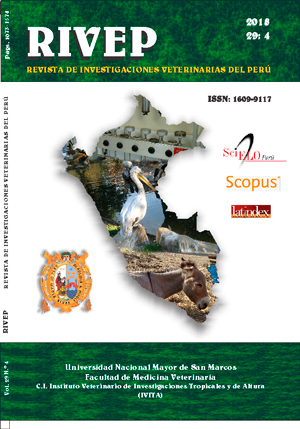Fermentation kinetics and in vitro degradation of three native creeping legumes of the municipality of Cuajinicuilapa, Guerrero
DOI:
https://doi.org/10.15381/rivep.v29i4.14340Keywords:
kinetic fermentation, degradation, centrosema, bean, bean-tamarindAbstract
The objective was to evaluate the fermentation kinetics and the in vitro degradation of the physiological parts of three native legumes of the municipality of Cuajinicuilapa, Guerrero. The substrates were pods, leaves and complete plant of centrosema (Centrosema plumiere), bean (Phaseolus lunatus var. silvester) and bean-tamarind (Phaseolus lunatus). The biodigestor contained 0.5 g of a substrate and 50 ml of culture medium. The biodigestor were incubated in a water bath at 39 °C for 72 h. Gas production was measured at 0, 2, 4, 6, 9, 12, 24, 36, 48 and 72 h. The gas production was used to obtain the parameters maximum volume (mV), rate of gas production (S) and time lag (λ). Dry matter degradation (DEGDM) and degradation of the neutral detergent fibre (DEGNDF) were determined by weight difference. The statistical analysis was a completely randomized design within a 3x3 factorial arrangement. The centrosema pod produced the higher mV, the centroid leaf and bean-tamarind pod the higher S, the leaf, plant and pod of centrosema the less λ, the pod of centrosema the higher DEGDM and DEGNDF. The centrosema leaf presented higher mV and S and less λ than the leaves of bean and bean-tamarind. The centroid sheath showed higher mV, DEGDM and DEGNDF and less λ than the bean and bean-tamarind pods (p<0.05). It is concluded that the evaluated components of the native creeping legume Centrosema plumiere presented better nutritional response in the in vitro evaluation than the other legumes.Downloads
Downloads
Published
Issue
Section
License

This work is licensed under a Creative Commons Attribution-NonCommercial-ShareAlike 4.0 International License.
AUTHORS RETAIN THEIR RIGHTS:
a. Authors retain their trade mark rights and patent, and also on any process or procedure described in the article.
b. Authors retain their right to share, copy, distribute, perform and publicly communicate their article (eg, to place their article in an institutional repository or publish it in a book), with an acknowledgment of its initial publication in the Revista de Investigaciones Veterinarias del Perú (RIVEP).
c. Authors retain theirs right to make a subsequent publication of their work, to use the article or any part thereof (eg a compilation of his papers, lecture notes, thesis, or a book), always indicating the source of publication (the originator of the work, journal, volume, number and date).










